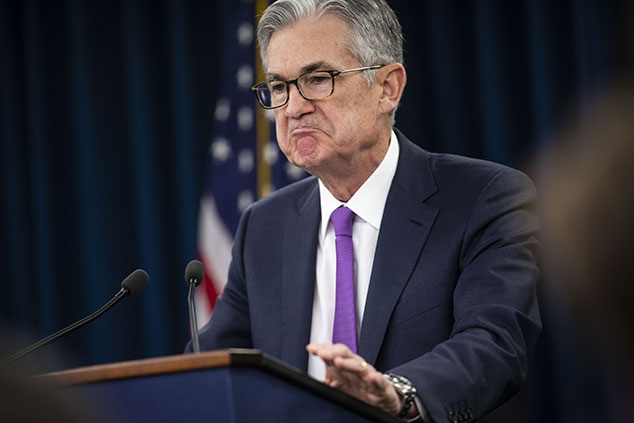
This article is taken from our FREE daily investment email Money Morning.
Every day, MoneyWeek’s executive editor John Stepek and guest contributors explain how current economic and political developments are affecting the markets and your wealth, and give you pointers on how you can profit.
The most important entity in global markets issued its latest pronouncement this week.
No I’m not talk about Warren Buffett (though he comes close).
I’m talking about the latest meeting minutes from the desk of the US central bank, the Federal Reserve.
How quantitative tightening works
We already know that the US central bank has thrown in the towel on the idea of showing markets who’s boss. We know who the boss is – it’s the S&P 500.
So the precise wording of these minutes isn’t desperately important. What matters is that the Fed has been sufficiently rattled by the reaction of markets to a wobble in the economy, to put rate rises on hold. In turn, that makes the hurdle for starting to raise rates again an awful lot higher than it was before Fed boss Jerome Powell pulled his U-turn earlier this year.
What was of more interest in the minutes is that, to cut a long story short, it looks as though the Federal Reserve is planning to end quantitative tightening (QT) later this year.
QT is the opposite process from quantitative easing (QE). QE is money printing. The Fed uses conjured money to buy government debt (and similar stuff, such as mortgage-backed securities). This does a couple of things to encourage more risk-taking in the economy.
Firstly, it keeps a cap on interest rates. When bonds are in demand (relative to supply), prices go up. And when bond prices go up, yields go down. (Over-simplified example: if a £1,000 bond pays £100 a year in interest, the yield is 10%. If the price of the bond goes up to £2,000, the yield is 5%.)
Secondly, a form of displacement activity takes place. The Fed (and other central banks) wade into the US government bond market. The US government bond is deemed the least risky investment in the world (or thereabouts). When a price-insensitive buyer with an endless appetite enters a market, it’s pretty pointless for anyone else to stay in it.
So all the other investors in the market move up the risk spectrum. You buy investment-grade corporate bonds instead of government bonds. You buy blue-chip equities instead of investment-grade corporate debt. You buy bitcoin instead of small caps.
In effect, QE amplifies risk appetite. So you get equities moving higher and “boring” bonds moving lower, because investors feel confident about buying higher-risk assets.
QT is the opposite of QE. Instead of buying bonds, the Fed sells them. In effect, this is burning money, rather than printing it. Now, a lot of economists (including the Fed) don’t seem to think that this should have much of an effect on markets.
But clearly, if you believe that QE had an impact, you have to suspect that QT will also have some sort of effect. It doesn’t necessarily have to be an equal and opposite effect – monetary economics is not physics. But the idea that nothing would happen at all seems strange.
So let’s say the central banks get out of the pool. Suddenly there’s no big player in the least-risky end of the market. So that displacement activity goes into reverse. Investors who are looking for risk-free assets start buying into the Treasury market again, rather than the high-end corporate bond market.
Everyone moves back down the risk spectrum. And so you get a decline in stock prices, for example. And interestingly, what happens to bonds is that – despite the fact that the big buyer, the central bank, has evacuated the market – that hole is filled by demand from freshly unnerved investors.
It’s odd that copper is rallying if we’re on the brink of recession
So what happens when the Fed changes its mind?
This is where it gets a little more tricky. Bond yields have fallen sharply since October last year. But we’re now at the point where – unless we actually see a recession some time very soon – there’s not a lot of reason for yields to fall much further.
From that point of view, I’m still not as convinced as some that recession is an impending risk. It seems to have become the accepted market narrative. Yet I remember a time about a year ago when the market consensus was that global growth would be absolutely wonderful, and synchronised.
That all seemed to be based on data too. And then it turned out to be totally wrong, and everyone changed their minds again.
My point is, ignore the often-confident tone of those making consensus arguments. It’s amazing how rapidly these arguments can flip around to the precise opposite with no one blinking.
What interests me more right now is the fact, for example, that copper is rising sharply. That doesn’t tend to happen when growth is falling off a cliff. Meanwhile, Chinese stocks appear to be rallying too. What if the big growth scare turns out to be just that?
If that is the case, and you simultaneously have the Fed warming up to stop QT, then the effect on risk appetite will be positive. It’s not as positive as QE, but it does represent a change in tone from the last few months.
Inflation could come creeping back onto the agenda. But this time, the Fed would be more circumspect about making any effort to snuff it out, for fear of jeopardising the market’s good mood.
In short, as Tan Kai Xian of Gavekal Economics points out, “there will more upside risk to yields than downside risk over the remainder of 2019”.